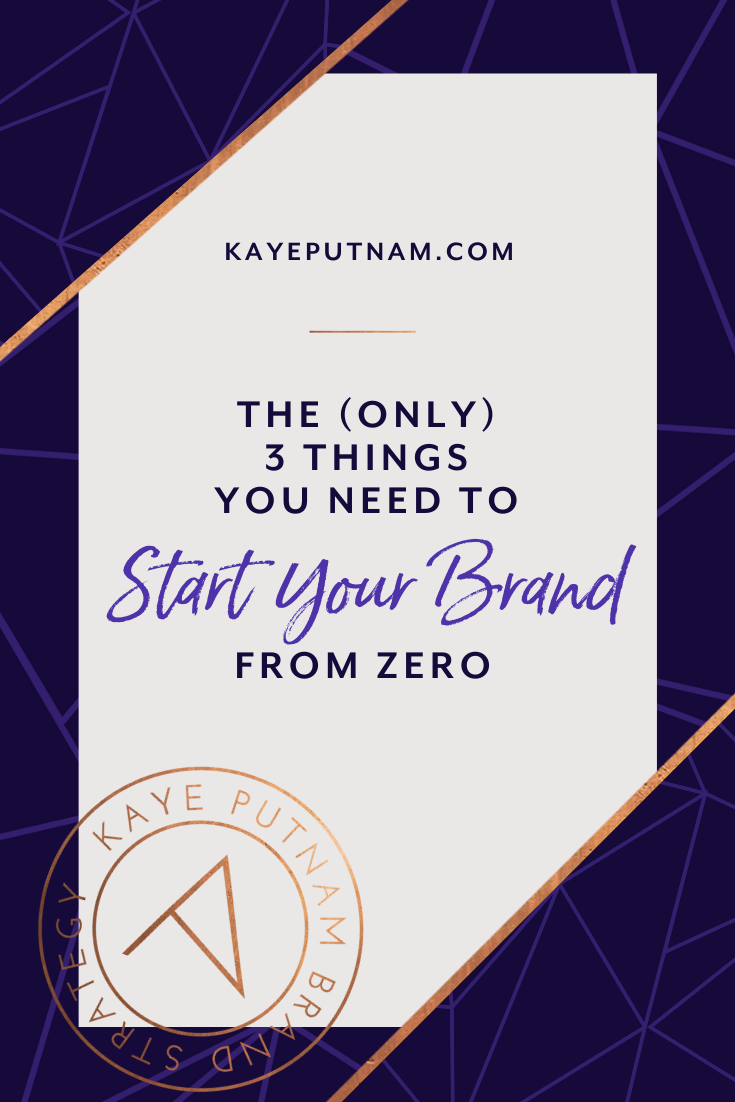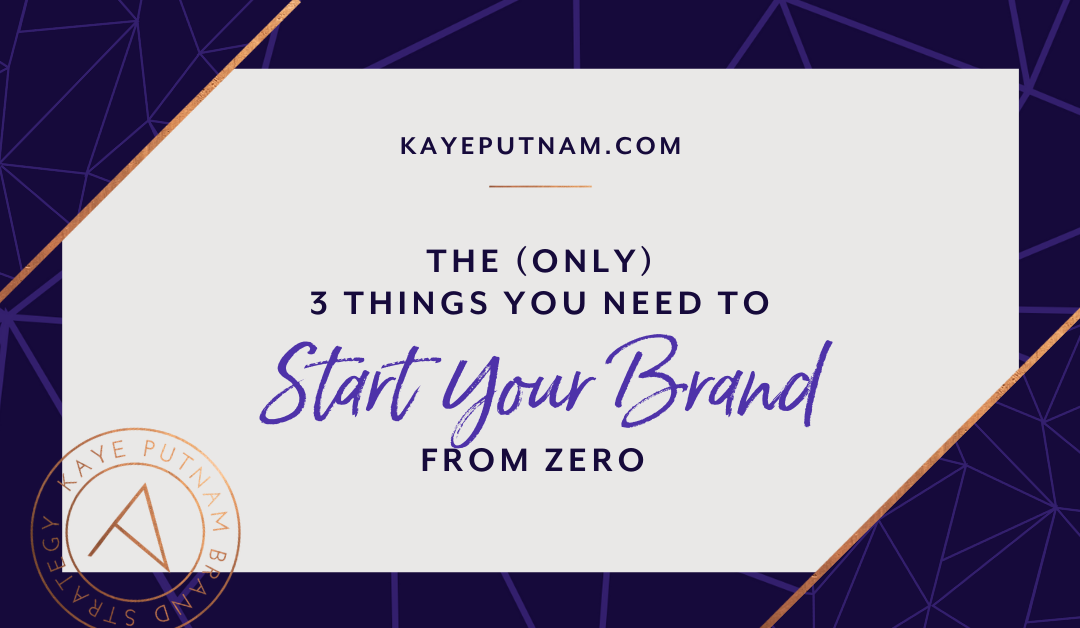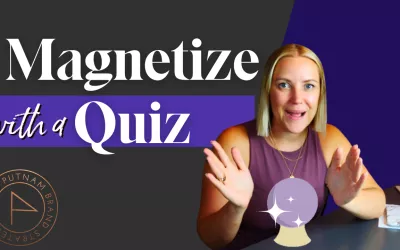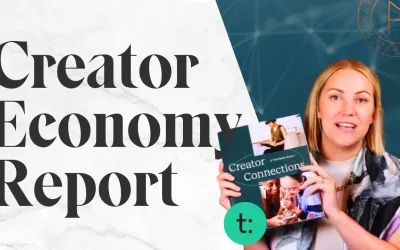“Kaye, can I ask for your advice?”
I nodded and she drew in an excited breath. I sensed her pulse quicken. There was an unmistakable fire in her eye.
And I knew that look, because I had seen it before.
It was the look of an entrepreneur with a reeeeaaalllly exciting new idea.
I got stoked too, because – truthfully – I live for this moment. 🙌🏽 Entrepreneurs around the world hire me and my team to define and build their brands. So I’m no stranger to the buzzy, heady energy that swirls around a new business idea.
My friend (We’ll call her Maria.) explained that she was ready to start something new.
She has a huuuuge talent and passion for makeup, and it was time to turn that hobby into a business. She’d do makeup for weddings, events, brand photo shoots… just on weekends at first, and then she’d see where it would take her.
So, she breathlessly asked for my advice about starting out.
A bunch of thoughts flew around in my head…
💬 I thought about my 1:1 clients, who are typically advanced stage entrepreneurs. (Since working 1:1 with me is a significant investment, entrepreneurs with revenue in the mid-6 to 7 figure range are the ones for whom my 1:1 services make the most sense – and deliver the best ROI.)
💬 I thought about my course students – entrepreneurs who invest in my Brand New Brand and Brand Advantage courses – or my VIP days. Some are more advanced, but many are at the beginning like Maria.
💬 Then my thoughts turned back to Maria. I wanted to meet her where she was at. I wanted to give her the best advice for her start-up status – and for starting as a side hustle.
And then it was like a bolt of lightning hit me. (in a good way 🤣).
Instantly, I knew what I wanted to tell her. It was this:
“I think you should build a Minimum Viable Brand – to start. Because there are only three things you need to be in business.”
Now, Dear Reader, if you are just starting your business, you are soooooo going to want to read on – for more about what I told Maria.
And, also (THIS IS BIG! —–>) If you’re NOT new – even if you’ve been at this entrepreneur thing for months or years – this could be a game-changer for you, too.
Because if you’re ever feeling overwhelmed and you need to get back to the basics (and who among us hasn’t been there???), what follows will help you focus on the essentials. Because everything you do when you’re at an advanced level should still tie back to these three things.
K, ready?
Let’s hone in on the (only) 3 things you need when starting your brand from zero.
🎥 As always, I’d love for you to read on for aaaaalll the goodness that’s in the details. And if you prefer video, you can opt to watch 👀 this content below.
To be in business, you need (only) three things.
As you dive in and start learning all about your new business, your industry, your competitors… it’s So. Freaking. Easy. to fall into the trap of thinking that you need everything right now.
Business cards. Facebook ads. Instagram. An LLC. Three tiers of offers. Chatbots. An email list. A trademark. Seventeen types of software. A Youtube channel. Professional photos… The list could go on and on, and it’s enough to make your head spin. 😵
Thankfully, you really don’t need to worry about so many little things when building your brand in the beginning. You really just have to get three basics down first.
So, with no further ado, here they are:
1. You need something to sell.
Now for some, this may seem a little… ummm… obvious? But, stick with me. 😀
You have to have something to sell. The traditional “things you sell” might be services or products. Many of my students and clients are providing services – like design, coaching, organizing, etc. Others are product sellers – offering things like printables, jewelry, art, or household products.
But, even if you happen to be building a brand that does something else, you are still selling something.
Maybe you are getting people to donate to a non-profit. (You’re selling the opportunity to give to something meaningful.) Or maybe you are driving people to your blog – which you monetize with ads or affiliate links. (You’re selling the content you create.)
Point being… The whole purpose of a brand is to connect with people and then influence them to buy or otherwise take action… In other words, to sell (with more ease, I might add. 😉).
So, it’s critical to get clear on what you are selling – because that’s a primary piece of the branding puzzle.
2. You need access to an audience.
The second element of your minimum viable brand is an audience.
(“Cause you know… If a tree falls in the woods and all… 🤣)
The great news here? There are as many different ways to get in front of people as there are things to sell!
So. Many. Options! #yay! But they basically fall into two categories – paid and organic. Let’s look at both.
You can pay for access to an audience.
For example, you can run ads on Facebook, LinkedIn, Pinterest, Google, or other platforms. If you’re targeting people in a certain geographic area, you could purchase placement with more traditional media – like a billboard on the highway, newspaper ads, or direct mail, for example.
Other examples of paid strategies:
- Buying or renting a space at a festival, an expo, or a conference where you sell directly – or promote what you sell
- Paying to join a local chamber of commerce or professional organization to gain access to its events and members
- Sharing your earnings with others who promote your offers to their audiences (i.e. affiliates).
You can go the organic route to get in front of an audience.
Examples include building an audience of people that visit your website. This works best when you have a conversion-friendly website, of course – one that is designed to effectively capture leads.
And if this 👆🏻sounds a bit jargon-y, “capturing leads” just means that you’re giving your website visitors an incentive to share their contact info with you. This can be accomplished with a contact form, or with a piece of free content that you offer to them in exchange for their email. (The latter is commonly called a “lead magnet” or “opt-in offer”.)
Other examples of organic strategies:
- SEO (search engine optimization), which essentially means you are using words, images, technology, and content on your web pages that help google show your website to people who are searching for things you help with.
- Pinning your content to Pinterest.
- Starting a YouTube channel, a podcast, or a Facebook group (or the like) and attracting people to your value-based content there.
- Speaking (for free; although this could also be a paid strategy) in front of groups of people who would benefit from learning about your area(s) of expertise.
Again, there are un-ending possibilities here. (More #yay! It’s one of the things that makes business so exciting, IMHO!)
However you choose to accomplish it, you need access to people…. And ideally people who are going to be interested in that thing that you’re going to sell! So you need to be mindful about who it is that you’re attracting – and you need a place to access the right people.
And, that leads me to the third element of your minimum viable brand, which is up next…
Pin this article to reference later! 📌

Pin this article to reference later! 📌
3. You need a sales mechanism.
First things first here. —–> A sales mechanism does NOT need to be complicated.
(Or it can be, and that’s okay too. But, it’s up to YOU how complicated you want to make it. And there are plenty of simple ways to sell.)
But, really… don’t let the word “mechanism” fool you! If you find an uncomplicated way to sell – and you do it repeatedly and consistently, you’ve got yourself a mechanism. 😉
You just need a way to make offers to people. This can be as simple as sitting down with somebody over coffee or on the phone – and just asking them to buy something, or to do something, or to read something. Or, it could mean opening an account on Etsy – or renting a table for every Saturday in the season at a local craft fair.
Or maybe you’re more advanced, and you do want to incorporate more automation and systems for selling into your brand. This could look like writing sales pages, teaching webinars, creating full sales funnels, or building and developing your own online e-commerce store.
Bottom line on this one: You need to have a place where somebody can easily take action on whatever it is that you’re selling – and a way for them to pay.
So, are they reading your blog? If so, you’ll want to make an offer in the post (via a CTA; a call to action). Are they pressing a ‘donate’ button to contribute to your non-profit? Are they seeing your product listings in a shop and deciding to buy?
In all of these examples, you’ll need a way to process monetary transactions. Will you collect credit cards over the phone at the conclusion of a phone consultation? Are you going to have a sales page with a ‘buy’ button at the bottom that connects to your Paypal account? Will you need to invoice customers – and if so, how will you do this?
(Psssst… I use and love Freshbooks for invoicing clients. It’s like a simpler – and prettier – version of Quickbooks. You can try it out by using my #affiliate link. If you end up purchasing, I get a small credit, but I only recommend it because I really like it!)
You do NOT need #allthethings.
Remember back up toward the top 👆🏻 when I made that semi-mind-numbing 😵 list of all the things you might think you need….?
Here’s the deal: You do need SOME of them to get started. But not all of them.
Procure the things you need for YOUR brand’s unique version of the 3 Elements of Your Minimum Viable Brand.
Get what you need to have:
✅ Something to sell;
✅ Regular access to an audience; and
✅ A way to sell and process money.
And then, as your brand advances, you can sub things in and out – as you learn about what works.
And (if you desire) you can layer in more strategies – plus the software, visibility platforms, collateral, ads, team members, etc that make those strategies work.
But for now, start with the basics. ⬅️
Speaking of basics, let’s get back to them.
Now… a note for my veteran entrepreneur readers… those who are already running those multi-faceted brands like bosses… 😎
Mr. or Ms. Rockstar business owner, heeeyyyy! If there’s a little part of you that feels j-e-a-l-o-u-s 😯 of the sheer simplicity that the business newbies can enjoy…
And if you ever feel…
… overwhelmed by all the moving parts
… unsure which actions and investments will truly move the needle
… like it’s time to get a little leaner or choosier about how you spend time
… then you, too, may want to audit your brand against the 3 Elements of a Minimum Viable Brand.
Look at each of your expenditures, systems, and how you (and your team) spend your time. Consider which of the “three elements” each action or investment supports. And (you saw this coming, ‘cause you’re a genius…) if something’s not aligned with at least ONE of the three? Consider eliminating or changing it. Because everything you do should roll up to:
✅ Improving and fulfilling on what you sell;
✅ Building your audience, and creating opportunities to expand that audience; or
✅ Selling.
And now, back to Maria…
So back to my friend, Maria the makeup artist. Want to hear how her brand-building is going?
- She’s already clear on what she’s selling.
Her makeup services will be for brides, bridal parties, and entrepreneurs who are getting brand photos taken.
- Her first decision was to decide how to get in front of an audience.
Her initial thought was to focus on building her Instagram account. She will be doing that, but it is kiiiiiinnnnnd of the slow route. (#TrueStory, right?) So, I suggested to her that she systematically tap into collaborations with people that have existing audiences.
So, she’s working on identifying local influencers – those who have a larger Instagram following than she does. She’ll offer specific, well-thought-out collaborations. (She’ll make it an easy “yes” for them – not just throw out a vague suggestion of a collab. 🤓)
Similarly, she’s also reaching out to related industry pros – like wedding photographers, florists, venue managers, and others who already have access to brides. And, she’s scoping out conferences and expos where her ideal clients will be.
- Finally, she’s putting a sales mechanism in place.
She’s committed to posting content and offers on two visibility platforms, and starting an email list and sending monthly newsletters. And, she’s investing in Dubsado, which is a system that can organize her lead collection, lead follow up, and invoicing. (If someone wants to just write her a check, that’s cool, too. She’s not going to make things harder than they need to be.)
And that’s it. For now. 😎 And it all feels super-manageable for her, which is especially important since she has about 10 hours per week max to devote to her brand – for now.
Minimum Viable Brand, Baby!
Oh, one last thing…
Maybe now you’re thinking, “Well this was fun and useful, but what do these 3 Elements of a Minimum Viable Brand have to do with branding, Kaye?” 🧐
Well, everything of course! Because…
Everything that you do to build a compelling brand makes one of these three things work better.
Much of the branding work that my clients and students do is about Step 1 – having something to sell. If you can position your product or service as radically different or better from other options in the market… if you can make it more special, more desired, more in-demand than other options… then more people are going to want it.
Getting in front of an audience regularly in Step 2? And the right audience, at that? Again, brand clarity – which includes a solid and deep understanding of your ideal customer – is key here. By knowing your ideal client more intimately… by understanding his pains, desires, and aspirations, you’ll improve your targeting.
And (this is crucial) doing the work means you can build your own audience – using your clear, magnetic brand. Then you have the ultimate influence over and access to that audience. Because when you can send an email to your list or post on your accounts – and get an access to thousands of people who are interested in what you have to say? #YouveArrived, Genius! 😎
Lastly, knowing your strongest, most compelling brand sets you up to improve your sales messages in Steps 3. Those “conversations” that you’re having – in which you’re making offers and collecting money? They get easier (and more frequent!) when your brand is in demand.
Want to take the next steps?
My new course – The Brand Advantage (Part course! Part experience!) is designed to facilitate your breakthrough to sharp brand clarity – FAST.
In this action-oriented 30-day program, our first order of business will be to create the conditions that make it inevitable for you to succeed.
Then, we’ll dive in and:
✅ Develop the habits… publishing, making offers, and making upgrades… that actually generate sales. (I’ll teach you how to incorporate all three into your schedule.)
✅ Do the work together to get *crystal clear* on your unique brand identity (so you can finally stand out!).
✅ Learn how to sneak right inside the brains of your ideal clients (and structure offers that they simply can’t resist.)
✅ Master the four types of content you need to draw them in to your orbit. (We’ll craft your content strategy and story vault.)
✅ Build your visibility machine – so you can stay consistent with content – even if it’s just you. (…and especially if you’d like your content to work hard for you when you’re not working.)
✅ Create the lasting memory triggers your brand needs to hit to be memorable and top-of-mind.
✅ Template-ize the process, document your brand standards, and cement your growth plan.
Are you in? Ready for game-changing clarity? To finally break out of your confusion rut, make progress in your business, and – frankly, to make bank?
Let’s get into action together, shall we?






Very nice article to start your own business. Did you describe what is really important and what can wait for now? I hope Maria is now successful.
I like your graphics and the design of the blog, very engaging!
All the best! Cheers, Pierre dasimperium.wtf